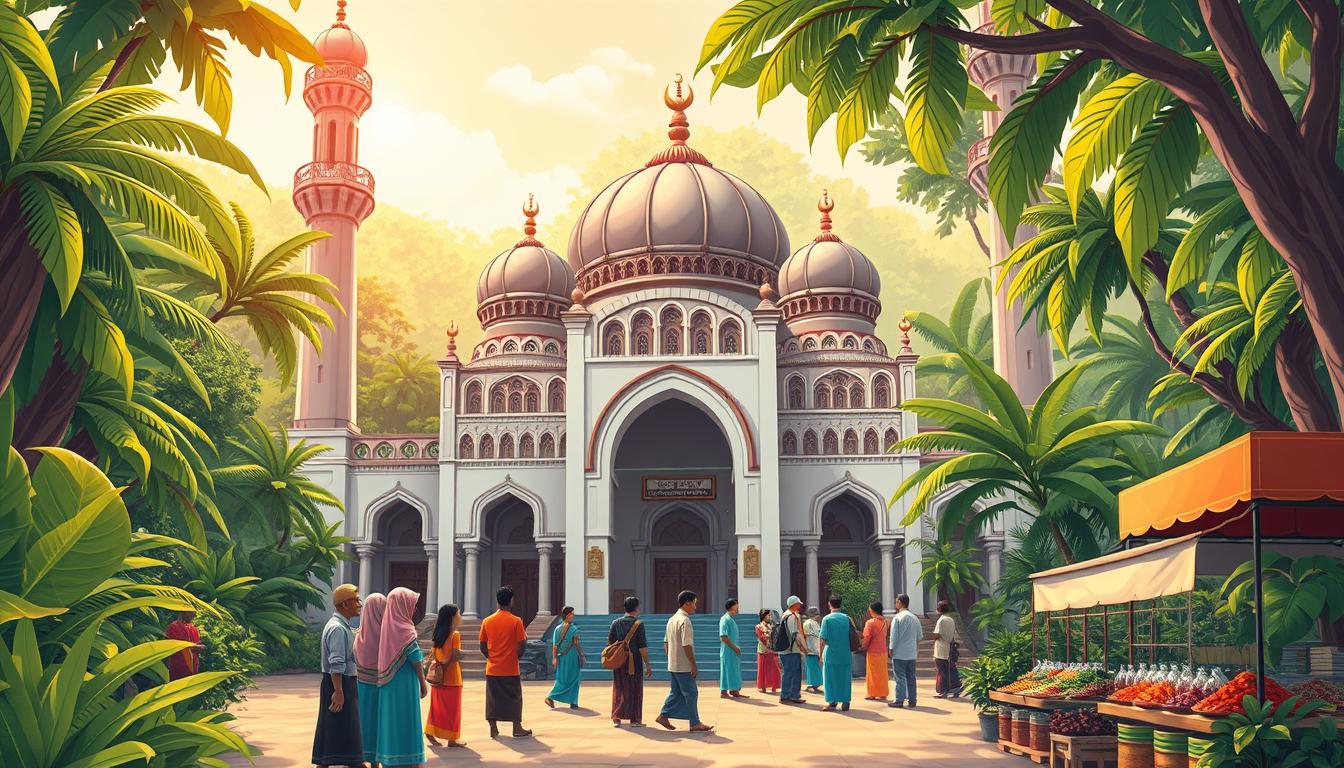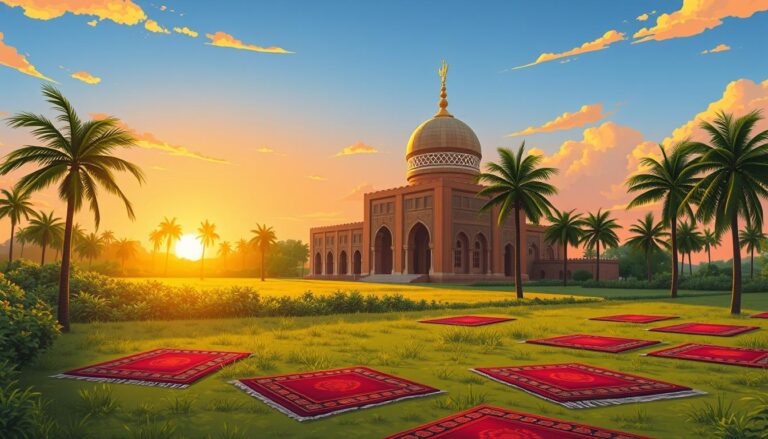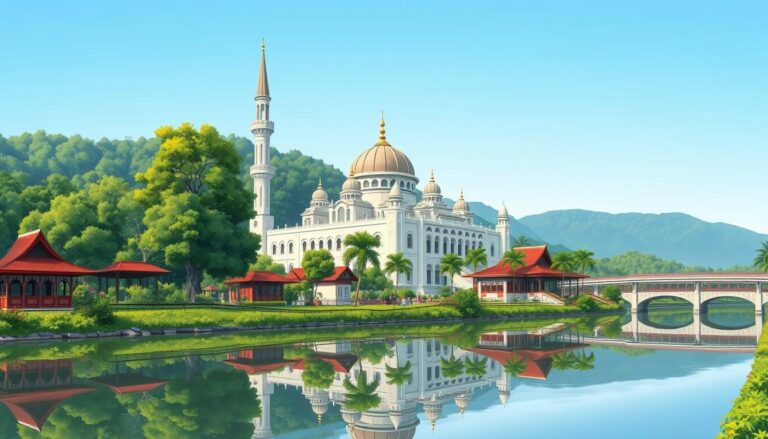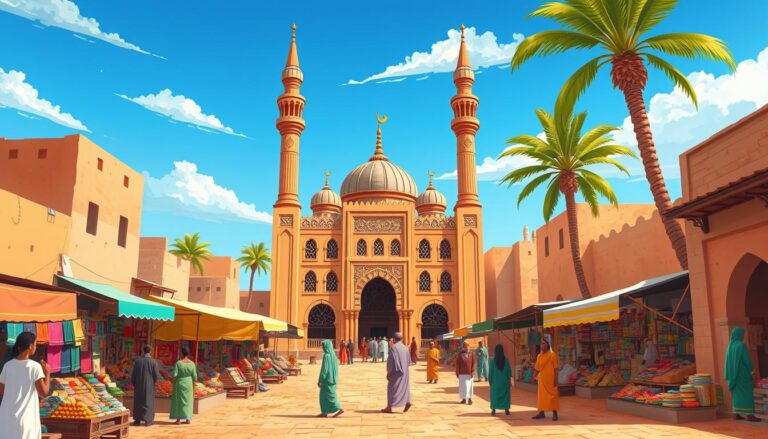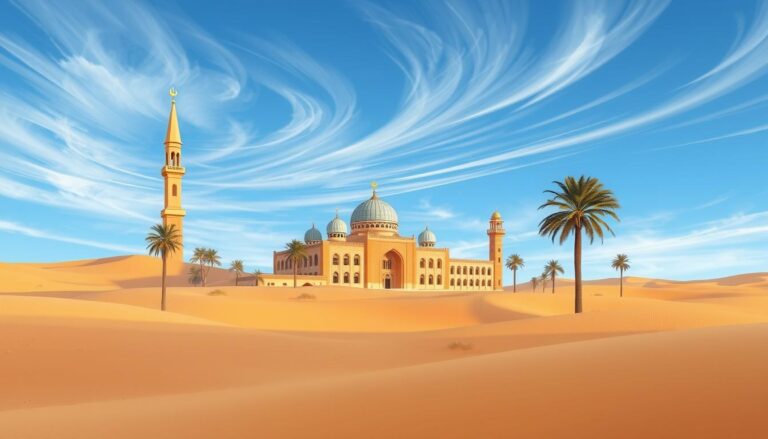Islam in Indonesia
Indonesia has the world’s largest Muslim population, with 87.06% of people, or about 244 million, identifying as Muslim in 2023. Islam has been present in the archipelago since the 13th century. It spread through trade, ruler conversions, and Sufism. Today, Indonesia is a secular state that recognizes six religions, despite being mostly Muslim.
The first signs of people converting to Islam in Indonesia date back to the 13th century. A 13th century tombstone of Sultan Malik al Salih in Sumatra shows this. Over time, Islam has deeply influenced Indonesian culture. People from Yemen and China have also left their mark.
Traditional puppet theatre, called wayang, has helped spread Islamic teachings. Despite being a secular state, Islam’s influence is still strong. This is seen in the political debates, like the 2017 Jakarta gubernatorial race. Research into Islamic organizations and movements in Indonesia helps us understand Islam’s complex role in the country.
Introduction to Islam in Indonesia
The story of Islam’s spread in Indonesia is both captivating and complex. It began as early as the 9th century, during the Umayyad and Abbasid caliphates. Some believe Sufi travelers introduced Islam in the 12th or 13th century from Gujarat or Persia.
Historical Spread and Significance
Before Islam, Indonesia was mostly Hindu and Buddhist, especially Shaivism. Its role as a trade hub helped spread Islam. By the 15th century, Islam grew peacefully, thanks to Muslim traders in coastal areas.
Demographic Overview
Today, Indonesia has the most Muslims in the world, with 87.06% of its population. Most are Sunni, with a Shia minority in Jakarta. The two big Islamic groups, Nahdlatul Ulama and Muhammadiyah, are huge, but they only cover half to a third of all Muslims.
“The spread of Islam in Indonesia was not a rapid and uniform process, but rather complex and slow, with evidence suggesting a gradual adoption of the religion over time.”
Islam in Indonesia: A Diverse Landscape
Indonesia is the world’s largest Muslim-majority country. It has a rich and diverse Islamic scene. Most Indonesian Muslims are Sunni, but there’s also a small Shia minority, about 1% of Muslims.
Sunni and Shia Denominations
The Shafi’i school of Islamic jurisprudence is the most followed in Indonesia, with 99% of Muslims. Yet, 56% don’t follow any specific school. This shows Indonesia’s unique blend of religious practices.
Schools of Islamic Jurisprudence
Indonesia’s Islamic scene is also shaped by kebatinan, a mix of Islam and local culture. This blend enriches the diversity of Sunni and Shia Islam in Indonesia. It also supports the growth of various Islamic schools of jurisprudence in the country.
“Indonesia’s Islamic landscape is a tapestry woven with diverse traditions, reflecting the country’s vibrant cultural heritage and the adaptability of the faith to local contexts.”
Traditionalism vs Modernism
In Indonesia, Islam is split into two main views: traditionalism and modernism. Traditionalism follows local leaders and Islamic schools. Modernism sticks to orthodox teachings but also values modern education.
Traditionalism in Islam in Indonesia is very popular, with 40 to 60 million followers. These followers are mostly part of Nahdlatul Ulama (NU), a big Muslim group started in 1929. It was a response to the rise of modernist ideas.
Modernism in Islam in Indonesia started in the late 1800s and early 1900s. It was inspired by changes in the Middle East. Muhammadiyah, a modernist group, was founded in 1912. It attracted urban, educated Muslims.
- The divide between traditionalism and modernism has shaped Indonesian Islam. Both have big impacts on the country’s religion and society.
- Traditionalism in Indonesia focuses on the four Islamic schools of thought, especially the Shafi’i maddhab. It also values education from pesantren, the local Islamic schools.
- Modernism in Indonesia pushes for following the Quran and Hadith. It encourages independent thinking and criticizes old rules and mixing of beliefs.
Even though traditionalism and modernism are seen as opposites, recent studies show they often mix. This shows that the lines between them are not always clear-cut.
“Tradition” and “modernity” in Islam are linked to accepting different views. This is different from modernism’s goal of clear, rational ideas and strict rules.
Islam in Indonesia: Regional Distribution
Indonesia, the world’s largest archipelago, has a diverse Muslim population. Islam is the dominant religion, making up over 87% of the population. However, the Muslim communities are spread out differently across the country.
Muslim Majorities and Minorities
In most of Java, Sumatra, West Nusa Tenggara, Sulawesi, and parts of Kalimantan, Muslims are the majority. But in Papua, Bali, East Nusa Tenggara, and some areas of Sumatra and Kalimantan, they are minorities. This is due to historical trade, migration, and local cultures.
The western part of Indonesia, like Java and Sumatra, has more Muslims. This is because of Arab traders and Islamic kingdoms from the 15th century. In the last three decades, migration has changed the demographics, making more areas Muslim.
The regional distribution of Muslims in Indonesia reflects the diverse nature of the country’s religious landscape, with pockets of majority and minority communities across its vast archipelago.
“Indonesia’s Muslim community is not monolithic, but rather a tapestry of diverse regional identities and traditions that have evolved over centuries.”
The Role of Islam in Indonesian Identity
Islam is key in shaping Indonesia, a country with 276 million Muslims. It’s deeply linked to being truly Indonesian, with 86% of Muslims seeing it as crucial. Christians, however, have a different view, with only 21% believing it’s central to being Indonesian.
The constitution of Indonesia mentions faith in “the One and Only God.” Yet, the country is officially secular and recognizes many religions. This shows the complex balance between religious diversity and Islam’s dominant role in Indonesia.
“The success of Islam in Indonesia is emphasized to be pursued in noble and civilized ways.”
Islam’s role in Indonesia has been widely discussed. While most people in the Nusantara region follow Islam, the country celebrates its diversity. It aims to promote a moderate, open, and inclusive form of Islam known as “Islam Nusantara.”
As Indonesia grows, it faces challenges in religious pluralism and national identity. The role of Islam in its culture, society, and politics is crucial. Organizations like Nahdlatul Ulama (NU) and Muhammadiyah play a big part in shaping Indonesia’s future. They help guide the nation through the Role of Islam in Indonesian identity and Islam and national identity in Indonesia.
Islam in Indonesia: Practices and Celebrations
Islam is deeply rooted in Indonesia’s culture. The country’s Muslim population, 88.2% of the total, celebrates many religious events. Eid al-Fitr, marking Ramadan’s end, is a major celebration.
Mosques are key community spots and learning centers across Indonesia. They host various Islamic rituals and events, like Friday prayers and major celebrations. Indonesia’s Muslims, Sunni, Shia, Sufi, and Ahmadiyya, enrich the country’s Islamic heritage.
Indonesian Muslims mix traditional and Islamic practices, known as “folk Islam.” This blend is seen in the country’s art, architecture, music, and literature.
“Islam in Indonesia has always been a diverse and dynamic faith, reflecting the country’s pluralistic society. The practices and celebrations of Indonesian Muslims are a testament to the enduring strength of their religious identity.”
Islamic organizations like Muhammadiyah and Nahdlatul Ulama shape Indonesia’s religious scene. They offer social services and education, integrating Islamic values into daily life.
As Indonesia changes, its Islamic practices and celebrations remain a big part of its culture. They adapt to the country’s evolving social, economic, and political landscape.
Islamic Organizations and Movements
Indonesia is home to two big Islamic groups: Nahdlatul Ulama (NU) and Muhammadiyah. These groups have shaped Indonesia’s religious and social scenes. They have millions of followers and a big say in politics.
Nahdlatul Ulama (NU)
Nahdlatul Ulama is a Sunni movement that values Islamic traditions. It focuses on religious tolerance and diversity in Indonesia.
Muhammadiyah
Muhammadiyah is a modernist group that supports orthodox theology and learning. It focuses on education and social welfare, aiming to update Islamic practices for today’s world.
Nahdlatul Ulama and Muhammadiyah are key players in Islamic organizations in Indonesia. Their different views add to the rich tapestry of Islam in the country.
“The emergence of #IndonesiaTanpaJIL is connected to the historical ideological rivalries between Islamic groups in Indonesia.”
The rivalry between these Islamic organizations in Indonesia has caught the eye of scholars. They study how these differences affect Indonesia’s religious, social, and political life.
Religious Pluralism and Challenges
Indonesia is known for its diversity and tolerance, recognizing six religions. These include Islam, Christianity, Catholicism, Hinduism, Buddhism, and Confucianism. Yet, the country’s commitment to religious freedom faces many challenges.
Most Indonesians, both Muslims and Christians, see diversity as a strength. However, intolerance is rising, and conservative Islamic groups are gaining power. This has raised concerns about the future of religious freedom.
Indonesia’s constitution guarantees religious freedom but also limits it. It promotes faith in “the One and Only God.” This has led to restrictions on those who choose not to identify with any religion. Religious pluralism in Indonesia is also complicated by the fact that Islam is the dominant religion, with around 87% of the population. Christianity makes up about 11%.
There are tensions between moderate and conservative Islamic groups. The conservatives want stricter Islamic laws. This has led to challenges to religious pluralism in Indonesia. Minorities face attacks, restrictions on building places of worship, and limits on public participation.
“Indonesia ranks in the ‘very high’ category for government restrictions on religion, based on a Pew Research Center report on global levels of religious restrictions.”
Despite these challenges, Indonesia’s diversity is a source of pride for many. Efforts to promote dialogue, tolerance, and peaceful coexistence are key. They help navigate the complexities of religious pluralism in Indonesia.
Conclusion
Indonesia’s Islamic landscape is complex and ever-changing. It’s shaped by centuries of history, cultural exchange, and diverse religious influences. Islam is the main religion, but Indonesia values religious diversity. This mix of old and new Islamic practices makes it stand out globally.
Indonesia faces challenges in balancing its Muslim identity with its diverse culture. The role of Islam in shaping the nation’s future is a big topic. Debates on traditionalism vs. modernism and regional Islamic practices add to the complexity.
The story of Islam in Indonesia shows the faith’s ability to adapt. It has become a key part of the country’s culture. As Indonesia grows, the influence of Islam on its future will remain a topic of interest and study.
Source Links
- How Islam came to dominate Indonesia
- Islam in Indonesia before the Revolution (Chapter 1) – Indonesia’s Islamic Revolution
- Spread of Islam in Indonesia
- Understanding Islam in Indonesia: Politics and Diversity – USINDO
- Islam in Indonesia
- The Changing Landscape of Political Islam in Indonesia: A Backgrounder | Alexander R. Arifianto
- The influence of religion in Indonesia
- Traditionalism (Islam in Indonesia)
- Modernism (Islam in Indonesia)
- Grave Matters: Ambiguity, Modernism, and the Quest for Moderate Islam in Indonesia
- Islam in Indonesia
- Introduction to Islam in Indonesia – Development of Indonesian Islam
- Project MUSE – Islam, Humanity and the Indonesian Identity
- Why Indonesian Islam Matters
- Chapter 5. Islam, Humanity, and Indonesian Identity
- Indonesia – Islamic, Culture, Traditions
- Islam in Indonesia – Praying for Indonesia
- Islam and tolerance in Indonesia
- Contemporary Islamic Movement, Popular Culture and Public Sphere in…
- Moderate Islamic Organisations and Contestation Over Political Theology: The Responses by Nahdlatul Ulama and Muhammadiyah Towards Islamism in Indonesia
- 5 facts about Muslims and Christians in Indonesia
- Navigating Diversity: Exploring Religious Pluralism and Social Harmony in Indonesian Society
- Conclusion
- The Uniqueness of Islam in Indonesia: Part Two – The Jenkins Center
- Advancing the discourse of Muslim politics in Indonesia: A study on political orientation of Kiai as religious elites in Nahdlatul Ulama

